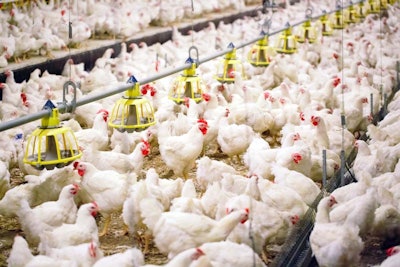
Confirmation of new HPAI cases has pushed South Korea’s total outbreaks in poultry to 26 so far this winter.
Latest outbreak to be reported by Yonhap news agency was in a flock of 25,000 meat ducks at a farm in Buan county in North Jeolla province.
In previous days, a further four HPAI outbreaks were confirmed.
According to the same source, birds tested positive for the H5N1 HPAI virus serotype from two chicken flocks in the same county in Gyeonggi province, and at a layer farm in South Chungcheong.
Also testing positive over the past week was another commercial duck flock, this time in North Chungcheong, reported the agriculture ministry.
Latest five outbreaks directly impacted 615,000 poultry. They bring to just over 2.39 million the number of poultry involved in outbreaks in South Korea since November last year. The figure includes mortalities and culls at premises with confirmed outbreaks.
Ahead of the Lunar New Year next week, the ministry is urging poultry owners to be on particular alert for signs of illness or unusually high deaths among their birds.
Last winter — between November 2020 and April of 2021 — South Korea culled 30 million poultry in order to prevent the spread of infection. In that season, HPAI was linked to a different virus serotype. H5N8.
Earlier this week, officials confirmed that a wild bird had tested positive for the H5N8 HPAI virus variant. This is South Korea’s first case of HPAI linked to this virus in this winter season. The bird was a swan found dead in a river near Busan, a city in the southeast of the country.
Further outbreaks reported in Japan
Over the past week, Japan’s veterinary authority has officially registered a further two outbreaks of HPAI in poultry flocks. In both cases, presence of the H5N1 virus was confirmed.
Increased mortality during the second week of January was observed at a commercial broiler farm, according to the World Organisation for Animal Health (OIE) notification. Around 150 of the 111,000 birds died at a farm in Kagoshima prefecture. Rest of the flock at Nagashima has been culled, along with all birds at an epidemiologically linked premises.
A few days later, 250 of the 66,000 broilers died at a farm in Chiba prefecture. Remaining birds at the premises in Yachimata city have also been destroyed.
Since the first HPAI cases in the country in November of last year, 12 outbreaks of HPAI linked to the H5N1 virus have been reported Japan. These have directly involved almost 853,000 of the nation’s poultry.
This season, Japan’s outbreaks have been distributed across the country. Previous cases have occurred in both Kagoshima — the most southwesterly prefecture — and Chiba, which is in the Greater Tokyo area.
In addition, Japan's agriculture ministry has reported over the past week a further outbreak in Chiba prefecture. A further four premises appear to have been linked to this index outbreak.
During the month of November 2021, presence of the H5N8 virus variant was confirmed at two farms and one wild bird in Japan.
HPAI detected in wild birds in Hong Kong, Israel
At opposite ends of Asia, wild birds have recently tested positive for the H5N1 HPAI virus.
After a brief hiatus, this serotype was detected again in Hong Kong. Affected was a winter-visiting water bird at a nature reserve in the territory, according to the OIE notification.
In Israel, more than 6,000 further cases in the wild population have been reported to the OIE. Covering the period mid-December to mid-January, around 7,000 more cranes died in the Hula valley, along with 36 other individual birds of different species at other locations.
Meanwhile, Russian’s veterinary authority has declared to the OIE that the HPAI situation in the Tuymen region has been “resolved.”
Between June and October of 2021, 85 pelicans and around 1,700 poultry were involved in outbreaks linked to the H5N1 virus serotype in this region of the Urals federal district. Based on official reports to the OIE, no new cases have been detected in this region for more than two months.
China records new human infections with flu of avian origin
Over the period January 14-21, the World Health Organization (WHO) was informed about two new cases of avian influenza A in human patients in the Western Pacific region. Both were in China.
The patient infected with avian influenza A(H5N6) virus was a 43-year-old woman from Guangdong province. She was admitted to hospital, and was reported to be in a critical condition. The woman had previous contact with live poultry and an animal market. This latest case brings to 64 the number of lab-confirmed cases with this virus reported to the WHO in this region since 2014. Of these, 29 patients have died.
More recently, the government in Hong Kong has recorded two further cases infected with the same virus in Mainland China. A 68-year-old man from Sichuan and a 55-year-old woman in Zhejiang were also in a critical condition in hospital.
Also reported to the WHO was a case of avian influenza A(H9N2) virus. Affected was a 5-year-old boy from Anhui province. His illness was mild, and he has recovered. The boy had previously visited a live poultry market.
Since December of 2015, 66 cases of avian influenza A linked to this virus have been reported in China, according to the WHO. Death was reported in two patients, both of whom had underlying health conditions.
View our continuing coverage of the global avian influenza situation.















